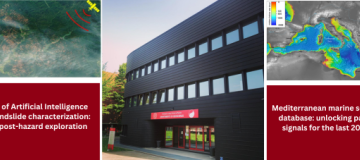
Seminars Excellence Project - October, 17
Speaker: Dr. Kushanav Bhuyan | Thursday, October 17 at 4.30 pm - Arduino Room Speaker: Dr. Allyson Viganò | Thursday, October 17 at 5 pm - Arduino Room
17.10.2024
As we look at the current systems under our disposal to understand landslide propagation, it has become clear in the past decade or so that capturing their dynamics, kinematic behaviour, rate of movement and other characteristics for predictive purposes is challenging. Considering discussions on climate change and expansion of settlements on (at times, weak) hillslopes, the propensity to landsliding has increased considerably in the past years. Moving forward, it has become pertinent to explore avenues that offer rapid and automated solutions to identifying not only regions struck by landslides but also potential regions where landslides could surface. In that endeavour, this talk will demonstrate some of the state‐of‐the‐art methods that have been applied in both directions of pre‐ and post‐hazard landslide analysis.
Catering to the former, current generation of time‐series and susceptibility models will be showcased that have shown considerable advancements in forecasting and predicting the location and timing of slope failures, albeit separately. The latter (post‐situation) is addressed by considering powerful computer vision models that specialize in dissecting signatures of landslides from remote sensing images and products, even during night‐time and under cloud‐cover situations. Coupled with morphological information of landslides, characterization of landslides to the extent of identifying their modes of movement, kinematic propagation, and volume estimates have also been realized with these recent models.
The Mediterranean is a crucial area for studying past climate dynamics due to its unique geography and hydrology. Its small size and rapid response to climate changes make it an ideal laboratory to evaluate the impact of marginal basins on global climate. Paleoclimatic data from the Mediterranean are vital for evaluating past events and predicting future scenarios. Here, we present a comprehensive paleoclimatic database covering nearly six decades of research in the Mediterranean, spanning the last 20,000 years. This database comprises more than 1,500 marine sedimentary cores and includes detailed descriptions of the oceanographic cruises and related cores.
For each core, we have documented virtually all available information on past environmental variables and their associated proxies. Our primary objective is to identify key environmental variables for assessing past climatic conditions over the last 20,000 years in the Mediterranean. We also aim to identify knowledge gaps and offer an overview of the main climatic proxies for this region. We gathered data from over 400 scientific articles and selected 36 well‐studied and/or potentially significant cores both from western and eastern Mediterranean. These cores enable a comprehensive graphical synthesis of the principal environmental variables and key proxies for last 20,000 years.





